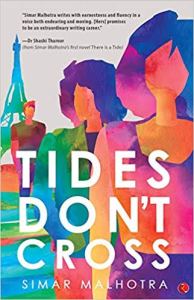I was absent from the blogging world for quite sometime and I won’t be saying anything about it in this post. I’ll be making a separate post for my rambling because a lot had happened. Like A LOT. I can’t say that I am fully back because then I would be lying but hopefully by the new year, I’ll be inspired and motivated enough to give my best to this book blogger’s community once again. And THANK YOU to each and everyone of you who supported me constantly even when you guys couldn’t feel my presence in the community.
Let’s just dive right into the review which is by the delayed as well (😅). Let me add that I recently read ‘Pride and Prejudice’, and not just the book but it’s analysis, critical perspectives and all of that (because everything is in my course). So, if you are reading this post, you might find references to P&P 😉

Book Title: Tides Don’t Cross
Author: Simar Malhotra
Total Number of Pages: 256
Publisher: Rupa Publications
Publication Date: 1st October 2018
Format: Paperback
Language: English
Genre: Fiction/Drama
BOOK BLURB
Sparks fly immediately when Rukmani—fierce and assertive in the best and worst possible ways—meets the gentle Ayaan in the magical city Paris. Meanwhile, back in India, her reticent sister, Mrinalini struggles to cope with the void of a loveless marriage and an early pregnancy.
Tides Don’t Cross follows these extremely interesting characters as their lives cross in surprising ways. Mrinalini, Ayaan and Rukmani wade through choppy tides, unaware of their common destiny. Deeply touching, this is an unforgettable story of thwarted desires, of love and its loss, of losing and finding oneself, and of falling and learning to rise.

For a story which is formulaic in its plotline, ‘Tides Don’t Cross’ makes for an engrossing and captivating book to read. I believe that the final denouement which is somewhat predictable only brings out the best in the story. It is when you know the answers to “who” and “how” that it becomes more frustrating to wait for a satisfying closure (the”when”). It is the anticipation that kills you. Simar Malhotra has used this to her benefit and have turned an otherwise boring and unstimulating story into an engaging one.
The three main characters—Mrinalini, Rukmani and Aayan are your day to day life characters and hence are realistic in nature. Mrinalini and Rukmani though are sisters in relation, it cannot be rightly said that they are each other’s confidant. There’s a stark contrast between these two characters (think Jane and Elizabeth). Mrinalini is more “feminine” with her characteristic attributes of shyness, modesty, helplessness, an urge to please others and acting “like a lady” while on the other hand, Rukmani is forthright in her speech, undaunted by difficult situations, and is feisty.
Neelam, the mother of the two daughters, is a domineering lady who thinks she knows better for her daughters than they do themselves, expects them to obey her all the time and is in the habit of imposing her opinions on others (think Lady Catherine minus the financial assets). Mrinalini is obedient by nature and tries to please her mother and thus, she is often treated like a doormat (no offence to Mrinalini).
Mrinalini, upon her mother’s commandment, agrees to enter into a loveless marriage with Surya. Apparently, he is an “appropriate” match for Mrinalini according to her mother, and she knows better than to disobey her orders. Before she even has the time to process everything, she becomes a mother. The rebellious Rukmani decides that she had enough of idling at home, leaves India to study abroad in New York and dedicates a semester to Paris.
Ayaan, Ayaan, my dear Ayaan, oh why did you have to be this charming human being devoid of arrogance and vanity that almost all the romantic heroes tends to possess and flaunts them pridefully?! Thank you Simar for not following the conventional “idealistic” way of portraying the hero. Rukmani and Ayaan engages in an affair which unfortunately ends as soon Rukmani leaves Paris.
The book is divided into three separate parts. Part I committed to depicting the home life , part II for the development of relationship between Rukmani and Ayaan, and Part III focuses exclusively on demonstrating if or not the “tides” actually “cross” (linking the three main characters together) each other, the story takes place after three years. The title of the book, ‘Tides Don’t Cross’ is symbolic of the love story that brews between the pages.
The author, Simar Malhotra employed what is thought to be the most common narrative technique, that is, the third person omniscient author technique. This technique allows Malhotra to be in complete control of the story and characters, she leads us wherever she wants us to follow but withholds her prejudices against the characters as well as the story. So the decision rests upon the readers as to how they want to perceive the characters and the plot. The three main characters are introduced by the author herself and not through dialogues or other characters. As opposed to the dramatic method of narration (which is not used in the novel), the author uses more narration and description than dialogues. The plot is developed by the narrator herself and most of the personalities of the characters are brought out by her too. Though the dialogues does help in revealing the personalities of the characters to some extent, it is not necessarily the main medium for their expressions and revelations.
Malhotra’s applied diction in the narrative though lacks the sophisticated and ornamental qualities, it should be kept in mind that her style of writing accommodates elegance in its simplicity. Given the popularity of micro poems and micro tales, it can be rightly said that today’s generation of readers prefers to read materials which are short in their construction but are adept in delivering heavy meanings (of course exceptions are always there, including me). Thus, ‘Tides Don’t Cross’ can be enjoyed and appreciated by most readers of today’s generation. The realism in the novel can also be acknowledged by the readers which is another likeable factor of the novel.

If I am being honest, I am neither overawed by the novel nor would I trivialize the contents of the novel. For a story which could have easily taken a turn for the bad, the author manoeuvred the story and saved it from dissolving into an utter mess. I can truly appreciate the author’s remarkable effort and wish her the best for her future writing ventures.
Recommended to readers who enjoy reading romance books, drama and any genres to be specific.

WANT TO GET YOUR BOOK REVIEWED?
*I am currently open to review requests for the month of December.
For more details, head over to my Review Policy page.
WANT TO KNOW MORE ABOUT ME?
I have listed down all my social media links in the Contact Page. I am known to be a friendly person, I don’t bite! Come, let’s talk 💜💙
CONNECT WITH ME ON:
WORDPRESS| TWITTER | FACEBOOK | INSTAGRAM| GOODREADS | GOOGLE+ | LINKEDIN |

